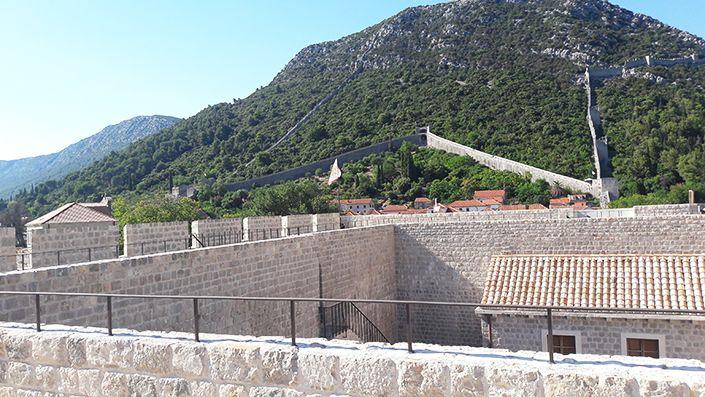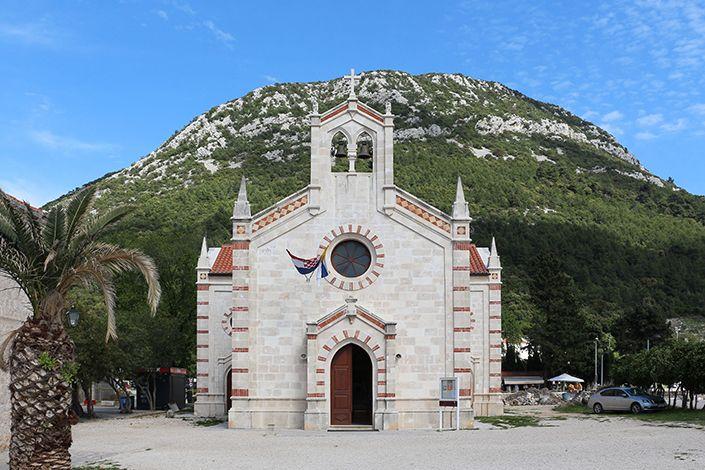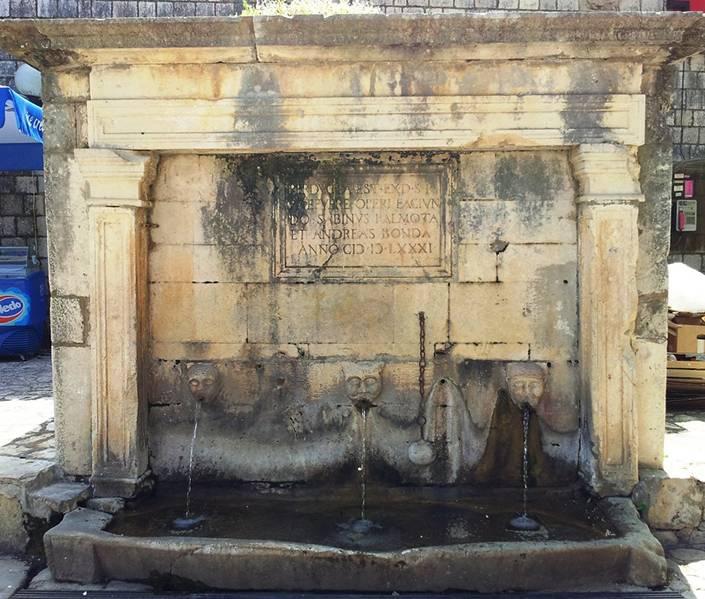He gazes down from his post on the lofty lookout, slowly turning 360 degrees. Sharp eyes combing the scene for any potential disturbances to the peaceful rhythm of life below. People bustle in the streets and on the placa (marketplace) between stone buildings with red-cobbled roofs, within the safety of tall walls surrounding the town. Their voices drift up on the breeze touching the tranquility enveloping him. Satisfied that all is well, he adjusts his helmet feeling the heat pounding upon his head and lifts his javelin to march down along the brink of the wall that stretches away in the distance. Once more, before he sets off, his eyes scan the green lushness, the blue sea and shimmering in the sunny haze, the white gold.
I had drifted off into an imaginary past of life in the 14th Century. A soldier standing guard on the ramparts of the then newly-built and most prominent wall that has become an historic relic. Have you heard of the Great Wall of Europe? Well if not, let me tell you about this ancient treasure... and what do you think the 'white gold' could be? Read on and you shall see.

If you've sailed Croatia's bounteous coastline, no doubt you've heard of the peninsula of Pelješac - the Empire of Wines - boasting the best of Croatian. It has a 70 km long span of hills and valleys running parallel to the Dalmatian coastline and a slice of Bosnia. We set sail from Dubrovnik in a north westerly direction on our short 35 km (22 nm) journey. It was a beautiful day for sailing and a gentle breeze chivvied us along as we sailed through the gulf of Ston. A beautiful stretch of warm, azure sea, the backdrop of fierce, dark, dolomitic Dinaric mountains standing vigil on the mainland, a couple of small islets dotted here and there and the green, rolling hills of the peninsula. Picturesque and peaceful!
As it's not recommended for vessels exceeding 3 m draft to enter the port of Ston, which narrows down at the bottom of the bay to shallow depths, we berthed in Broce - not even 2 kms away. Climbing onto the tender, we continued on the final leg to our destination.
If you were coming from Hvar in the North, you could come down through the Neretva Channel where the Neretva River spills into the bay to create an ideal environment for cultivation of mussels and oysters, which is yet just another legacy of this area. You would pass by concrete structures that form foundations for the future Pelješac Bridge to join the peninsula to the mainland and the isthmus of the Bosnian peninsula, to enter into the bay of Mali Ston. Because of its clean waters, the bay was declared a Special Nature Reserve in 1983. It is 28 km /15 nm long and averages a width of 1 nm, with a sharp narrowing to 0,33 nm, and depths of between 7 and 28 metres. So it would take longer to navigate and is not ideal as navigating a yacht between the shell farms, the variable currents and sudden changes in water level (seiches) make it difficult. Also from Hodilje onwards, only draft vessels of up to 3 m can continue.
From Broce we could see the captivating scene of medieval towers and walls straddling the hill and surrounding the small town of Ston and, as we drew closer, the salt flats and Veliki Kaštio (Big Castle) with a moat running into the sea. It's only slightly bigger than its neighbour, Mali Ston, a km away. They are both positioned on the section where the peninsula and the mainland meet known as "The Gateway to Pelješac". They, together with Pelješac were purchased in 1333 from the Ban in Bosnia and the Serbian king by the Republic of Ragusa - a stately maritime republic with the city of Dubrovnik at its centre.
Ston was inhabited in prehistoric times and Mali Ston was founded in 1335 as a defensive town to protect Ragusa. In 1808 the republic was conquered by Napoleon's French Empire and became part of the Napoleonic Kingdom of Italy. The most distinguishing feature is the long stretch of wall connecting the two towns and it was this complex of walls, towers and forts, which was constructed from 1358 onwards, that drew us to this place. Known as the Great Wall of Europe, it stretches 5,5 kms and is the largest in Europe and the second largest defensive wall after China's Great Wall. Remarkable!
The great thing about sailing is that it's a breeze when the weather conditions are favourable, and we arrived energised and ready for exploration. We unanimously decided that it was imperative we first take a walk along the wall. After a stop off at the shop to buy some snacks, drinks and water, we set out through the entrance close to the Veliki Kaštio, which is currently under restoration.
The entrance fee is 70 kuna pp (€10) and children up to 12 are free. For groups of 10 plus it's 50 kn (€7) each. In the summer season from April to October, they are open from 8am to 6.30pm and from 9am to 3pm throughout the rest of the year.
The first stage of the wall leads to the to the Nad Vodom (above water) tower, which gets its name from the source of a freshwater spring just below it. Here we continued straight up the Podzvizd Hill on a steep and pretty strenuous stretch leading to Fort Stoviš. It was worth the effort as 15 minutes later the reward was a spectacular view. We took a breather and there was silence as we contemplated the landscape. My friend sighed, saying, "Magical and timeless". As for me, this is where my story started, imagining a sentry standing guard over this idyllic setting so long ago!
This viewpoint is on the top peak of the walls surrounding the town, which form a kind of irregular pentagonal shape. Vineyards and olive groves flourish in the Ston fields below and the old Napoleonic Road, built in the 19th Century by Napoleon's army, stretched away hugging the coastline, into the distance. The road's network of educational hiking and biking trails traverses the entire peninsula and offers some fantastic cultural, archaeological and natural sites to visit.
Ston was originally positioned in a slightly different location and had several churches, of which the only one remaining today is the hilltop church of St. Michael. There Roman tombstones, fragments of decorative plaster and ancient ceramics were discovered - most notably a fresco with a fish shell motif from the 6th century and a relief from the 11th century depicting a human figure with a crown on his head. These and other archaeological and sacral treasures can be seen in the Lapidary in Ston town centre. The audio-visual play, "Cum grano salis" ("With a grain of salt"), depicting the turbulent history of the area, particularly in the early 14th Century, can be experienced at the Kaštio Fortress.

St. Michael's church survived four major earthquakes and even the bombing by Allied forces in 1944 that flattened the church of Mary Magdalene. The old town Ston was completely destroyed in the earthquake of 1252 and rebuilt on its current position. The churches of St Blaise and St Nikola are still prominent features in the town.
Beyond the town, the blue Adriatic sea and the renowned salt pans shimmered in the humid haze. Salt was an extremely valuable commodity in Ragusan times and this is what came to be known as "white gold"! Hence one of the main reasons for the fortifications - to protect the saltworks from potential attacks from the mainland. It also has great historic value as it's probably the longest surviving ancient saltworks in the world still producing 2,000 tons annually using the old traditional method. 58 salt pans divided into 5 groups relating to the phases through which salt passes; 9 crystallisation basins named after saints, except for Mundo (meaning world) which was originally intended to provide salt to the poor who couldn't afford it. An organic gift from the sea, sun and wind ... and the salt flower ("Fleur de sel"), with its delicate, crystalline flower-like structure, used only to flavour food.
The Ston complex encompassing the walls, fields, Mali Ston Bay nature reserve, saltworks and two towns is a UNESCO World Heritage Site, not only of historic value, but also accredited for its urban planning structure. The defences were designed and constructed by renowned architects including Juraj Dalmatinac (one of the leading architects for Šibenik Cathedral). Huge respect for the human hands building and toiling on the steep and rough terrain. Can you imagine how difficult that must have been?
Originally the limestone walls were 7 km long, and between 5 to 10 m high (scary to think there were no handrails in the old days) and the complex, completed in the 15th Century, included 40 towers and 5 forts of which 20 towers are still standing. Sadly after the fall of the Republic of Ragusa, parts of the walls were demolished and later stone was taken from the walls to build schools and other community buildings, as well as an arch for the Austrian Emperor's visit in 1884. The wall around Mali Ston was knocked down, but thank goodness someone saw sense and further demolitions were halted after World War II. In 2009 a 50-year renovation was completed, which took that long as they authentically hand-carved each new stone as per the original construction. That's quite something!

We retraced our steps back down the steep section of wall and then rallied into a sharp climb up, up, up the long stretch leading to Mali Ston. Through the Dobri Tower, where a footpath splits off up the hill to the ruins of the Bartholomew Fort at the summit. We had been told that the path was a bit overgrown in places and it was a venture for serious and well-prepared hikers. So we continued towards the Dolina Tower and with each step admired the incredible views all round. It took us about 40 minutes to reach Mali Ston entering from the crest of the hill alongside the fortress of Koruna (currently also under repair) standing guard above the charming town.
Mali Ston's port, built to resemble Dubrovnik's, has a circular tower, three arsenals and a gate upon which St. Blaise's (patron saint of both towns) stone head surveys the scene. An attractive waterfront lined with restaurants and shops greeted us.
Every year in September these walls of beautifully laid stone play host to the Ston Marathon. No wonder it is known as one of the most difficult marathons in the world. Our steady walk already had me puffing and panting. Oh, and by then we had worked up an appetite and my mouth was watering at the thought of the famed handpicked Ston oysters originally collected by Romans in the 16th Century and to this day acclaimed to be the most delicious in the world.
Ston also hosts an annual Salt Harvest Festival and of course, an Oyster Festival. We still had to tread our return trip back the way we had come, but if you had enough time, you could join an excursion on a boat to see the oyster farms in the Kuta Bay leading from Mali Ston and enjoy an oyster spread on board.
Anyway, there we were, our happy bunch of travellers in a gorgeous setting tucking into appetising platters of oysters ... just adding a squeeze of lemon and a dash of Ston salt. Washed down, of course, with Mali Plavac, the ruby red wine that Pelješac is famed for. Živjeli! Cheers! To a long life! Oysters are well known as an aphrodisiac, evidenced by a sign at the restaurant which proclaims: "Eat Oysters Love Longer".
What a satisfying way to feast on a remarkable day, immersed in the spirit of this most precious place that offers the best of history, gastronomy, oenology and the splendour of nature. These proud walls are custodians of tales and fables half-forgotten in the mists of time, yet still graciously bestowing their gifts to be remembered and discovered all over again.
__
Author: Diana Karmela
Photos by Wikipedia, Shutterstock




